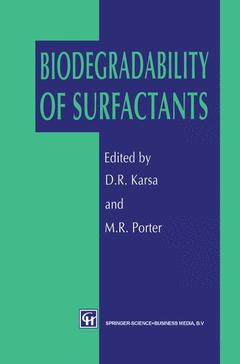Biodegradability of Surfactants, 1995
Langue : Anglais
Coordonnateurs : Karsa D.R., Porter M.R.

The awareness and development of 'biodegradable' surfactants pre-dates current pressures by the environmental movement by nearly three decades, wherein a responsible industry mutually agreed to replace 'hard', non-biodegradable com ponents of household detergents by 'soft', biodegradable alternatives, without course to legislation. The only requirement at that time was for surfactants used in detergents to exhibit a 'primary biodegradability' in excess of 80%; this referring to the disap pearance or removal from solution of the intact surface active material as de tected by specified analytical techniques. This proved useful, as observed environmental impacts of surfactants, e.g. visible foam on rivers, are associated with the intact molecule. Test methods for 'primary biodegradability' were eventually enshrined in EU legislation for nonionic surfactants (Directive 821242/EEC, amended 73/404IEEC) and for anionic surfactants (Directive 8212431EEC, amended 73/405IEEC). No approved test methods and resultant legislation have been developed for cationic and amphoteric surfactants to date. The environmental classification of chemical substances, which of course includes surfactants, and associated risk assessment utilises a second criterion 'ready biodegradability'. This may be assessed by a number of methods which monitor oxygen uptake (BOD), carbon dioxide production or removal of dis solved organic carbon (DOC). Some surfactants which comply with the above Detergents Directive are borderline when it comes to 'ready biodegradability'.
1 Introduction to surfactant biodegradation.- 1.1 Introduction.- 1.2 Biodegradability and the replacement of soap in detergent products.- 1.3 Biodegradation, biodegradability testing and interpretation of results.- 1.4 Sewage treatment processes and their significance for surfactants.- 1.5 Biodegradability test methods for surfactants.- 1.6 The replacement of tetrapropylene benzene sulphonate (TPBS).- 1.7 Surfactant biodegradability and legislation.- 1.8 Surfactant analysis.- 1.9 Conclusions and thoughts for the future.- References.- 2 What is biodegradation?.- 2.1 Setting the scene: Microbial nutrition and the carbon cycle.- 2.2 Surfactants as potential microbial nutrients.- 2.3 Surfactant biodegradation in the environment.- 2.4 Laboratory models of surfactant biodegradation.- References.- 3 Biodegradability testing.- 3.1 Introduction.- 3.2 Nature of biodegradation and influencing factors.- 3.3 OECD and EEC tests for primary biodegradability of surfactants.- 3.4 List and synopses of existing methods for ultimate biodegradability.- 3.5 Analytical methods.- References.- 4 Testing strategy and legal requirements.- 4.1 Selection of tests: strategy of testing.- 4.2 Validation and interpretation of results.- 4.3 Legal requirements.- References.- 5 Biodegradability of anionic surfactants.- 5.1 General characteristics of anionic surfactants.- 5.2 Application of anionic surfactants and their environmental relevance.- 5.3 Particular structure and application features of anionic surfactants.- 5.4 Biodegradation of anionic surfactants.- References.- 6 Biodegradability of cationic surfactants.- 6.1 Introduction.- 6.2 Biodegradability of cationic surfactants in OECD Screening tests.- 6.3 Behaviour of quaternary ammonium salts in waste water treatment plants.- 6.4 Biodegradation routes of quaternary ammonium salts.- References.- 7 Biodegradability of non-ionic surfactants.- 7.1 Introduction.- 7.2 Structure of polyglycol surfactants.- 7.3 General biodegradability.- 7.4 Mechanisms of biodegradation.- 7.5 Biodegradation of polyglycols.- Acknowledgements.- References.- 8 Biodegradability of amphoteric surfactants.- 8.1 Introduction.- 8.2 Structural elements and biodegradation in general.- 8.3 Alkyl betaines.- 8.4 Alkylamido betaines.- 8.5 Sulphobetaines and hydroxysulphobetaines.- 8.6 Alkylamphoacetates.- 8.7 Polycarboxyglycinates.- 8.8 Alkylamphopropionates.- 8.9 Imidazolinium betaines.- Acknowledgements.- References.
Date de parution : 09-2012
Ouvrage de 257 p.
15.5x23.5 cm
Thèmes de Biodegradability of Surfactants :
Mots-clés :
Acetat; Ammonium; Compound; biodegradation; degradation; environment; iron; structure
© 2024 LAVOISIER S.A.S.



